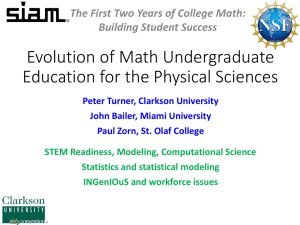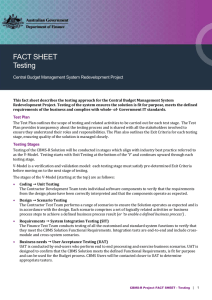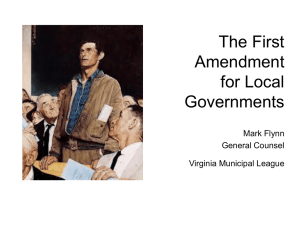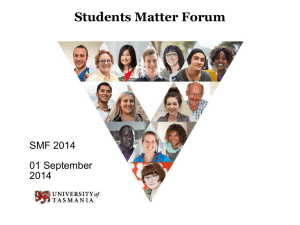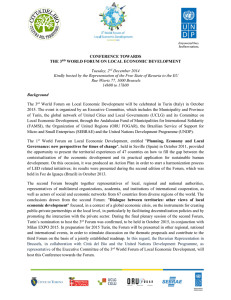Peter Turner - Conference Board of the Mathematical Sciences
advertisement
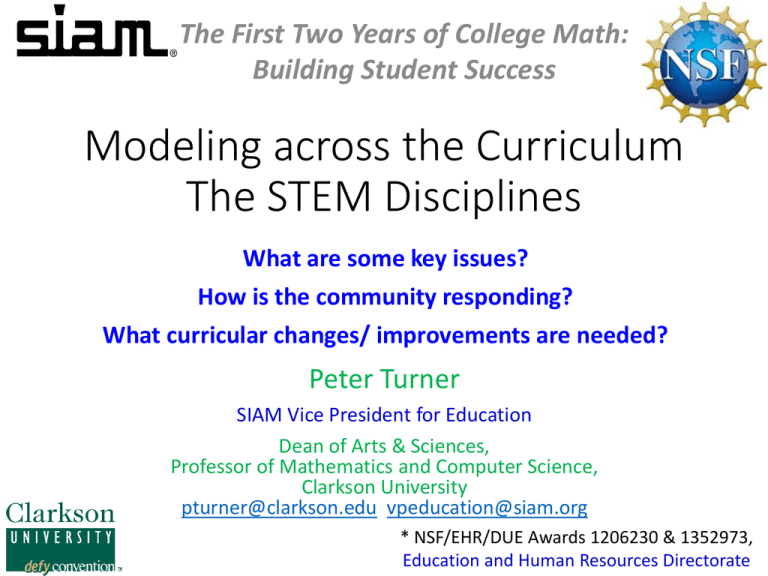
The First Two Years of College Math: Building Student Success Modeling across the Curriculum The STEM Disciplines What are some key issues? How is the community responding? What curricular changes/ improvements are needed? Peter Turner SIAM Vice President for Education Dean of Arts & Sciences, Professor of Mathematics and Computer Science, Clarkson University pturner@clarkson.edu vpeducation@siam.org * NSF/EHR/DUE Awards 1206230 & 1352973, Education and Human Resources Directorate Key issues: Some of them • Preparation & Readiness for STEM majors • CU STEM admissions data • Outdated curricula and delivery methods • PCAST Engage to Excel • Math 2025 • Workforce issues • Very few “future math profs” in large core math classes • Teach the students we have, not the ones we dream of • INGenIOuS • Student “demands” for relevant education • BUT with care over “training vs. education” CBMS Forum October 2014 The First Two Years of College Math: Building Student Success 2 STEM doesn’t happen CBMS Forum October 2014 The First Two Years of College Math: Building Student Success 3 So, what is being done? • Multiple initiatives in the Math Sciences community • • • • Modeling across the Curriculum TPSE-Math MAA-led Common Vision for Undergraduate Math in 2025 CSE Future Workshop • Multiple curricular reports: • CUPM Guidelines (2015?) Greater emphasis on applied topics than previously • SIAM Report on Undergraduate CS&E (2011) • SIAM Report on Applied Math undergraduate programs (2014) • Future Directions in CSE Workshop, August 2014 • INGenIOuS CBMS Forum October 2014 The First Two Years of College Math: Building Student Success 4 So, what is being done? • Changing nature of both Math majors and of “service” courses • Modeling, computation, statistics • Project-based learning • Teamwork, etc. • SIAM Undergraduate Research Online, SIURO • MAA-SIAM PIC (preparation for Industrial Careers) Math project • More internship opportunities • Implications for K-12 and Teacher Preparation CBMS Forum October 2014 The First Two Years of College Math: Building Student Success 5 Modeling across the Curriculum • Two SIAM-NSF Workshops • August 30 -31, 2012 at NSF • January 12- 14, 2014 at ASA Draft report near complete • Engage and Keep Young People in STEM, • from K12 through Undergrad (and Grad) Studies, and into the Workforce CBMS Forum October 2014 The First Two Years of College Math: Building Student Success 6 MaC I Recommendations Four categories • Expanding modeling in K-12 • Development of a high school one semester, or one year modeling course (with stratified content) • Develop modeling-based undergraduate curricula • Develop a repository of materials for math modeling instruction and understanding CBMS Forum October 2014 The First Two Years of College Math: Building Student Success 7 MaC II • Three primary topic areas: • Early grades (Rachel Levy coordinating) • Middle/High School (Katherine Socha) • Undergrad curricula (Jeff Humpherys) • MaC II process: • Developing clear list of deliverables • Intro from Joan Ferrini-Mundy • Keynote on Math2025, Panel on opening afternoon advance this process CBMS Forum October 2014 The First Two Years of College Math: Building Student Success 8 MaC II Panel • Used to “set the scene” and review some of the discussions at MaC I: • Definition of modeling • Stand alone vs. infusion • Setting goals for MaC II sessions • The role of algorithms • Modeling at different educational levels and in different disciplinary contexts • Assessment Panel members: Jeff Humpherys, Rachel Levy, Katherine Socha Moderator: Turner CBMS Forum October 2014 The First Two Years of College Math: Building Student Success 9 Discussion Topics • Programs: • Courses, Programs, Degrees, Summer Experiences, Internships • “Infusion” or stand alone? (“Trojan mice”) • Materials: • Books, Videos, Software, Posters, Websites, MOOCs? • Informal education (MoMath?) • Training: • Pre-service and in-service • Ways of interacting with teachers/ faculty/ TAs and students (and perhaps parents) CBMS Forum October 2014 The First Two Years of College Math: Building Student Success 10 Some MaC II undergrad recommendations* • Proposal for NRC Study/Report Response to Joan Ferrini-Mundy’s Challenge to think about effective ways to educate students at the crossroads of: • Mathematical modeling • Data science • Information science • Computational science • Computational thinking * Credit to Jeff Humpherys for some of this content CBMS Forum October 2014 The First Two Years of College Math: Building Student Success 11 Modeling and the Pipeline: Attracting and retaining STEM students A study/paper on recommended topics to address: • How to achieve the 34% increase in Engage to Excel. • Multiple entryways? A non-calculus track for freshman modeling? • Diversity • Focus on Jobs! • Teaching needs to match what we expect CBMS Forum October 2014 The First Two Years of College Math: Building Student Success 12 Two Recommendations for Professional Organizations • Form a SIAM Activity Group (SIAG) in Applied Mathematics Education • Done! SIAG Ed was approved at SIAM Council and Board in July Begins operation in January 2015 • Plans for First SIAG Ed conference to coincide with, and broaden, MaC III • SIAM Education VP needs to continue to work with other VPs and other societies • New VP for Education starts in January 2015, Rachel Levy CBMS Forum October 2014 The First Two Years of College Math: Building Student Success 13 What are “new” key areas for undergrad math? A modern math sciences undergraduate education should include at least some introduction to • Algorithms and Analysis (Data Structures, Approximation Theory, Numerical Analysis, Computational Science) • Distributed Computing and Big Data (MPI, Hadoop, noSQL) • Data Analytics (Regression, Estimation, SQL, R/Python) • Modeling with Probability and Stochastic Processes • Bayesian Statistics and Machine Learning • Dynamical Systems (ODE, PDE, SDE) • Optimization and Control CBMS Forum October 2014 The First Two Years of College Math: Building Student Success 14 Why? Actual Job from CareerBuilder.com CBMS Forum October 2014 The First Two Years of College Math: Building Student Success 15

